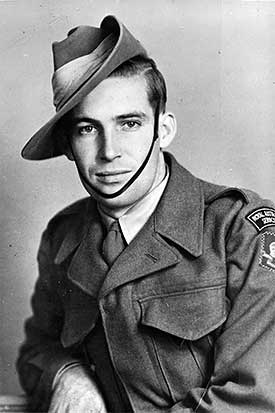China Intervenes in the Korean War
United Nations forced to retreat south
The Chinese military in Korea were known as the Chinese People’s Volunteers (CPV)...
- United Nations forced to retreat south
- Description and sequence of events

Studio portrait of Private (Pte) Kevin Leslie ‘Joe the Ghost’ Simms, of Bendigo, Vic, and of the 3rd Battalion, The Royal Australian Regiment (3RAR). Pte Simms is one of four soldiers of a Bren gun team featured in the Battle of Kapyong diorama in the Korean War gallery of the Australian War Memorial. [AWM P06247.001] ... Enlarge the photo portrait of Private Simms
Between October 1950 and May 1951 the CPV launched five offensives against United Nations Command (UNC) forces. The ‘First Phase’ offensive began on 25 October 1950 when 180,000 previously undetected CPV launched a surprise attack from the mountains of central North Korea. The CPV isolated and destroyed many ROK units and inflicted heavy losses on US units. The US 8th Army retreated with CPV troops in close pursuit. Having achieved their objective, stopping the UNC advance into North Korea, the CPV halted their first offensive on 5 November.
By 27 November the recovered UNC forces began their ‘Home by Christmas’ offensive. The CPV stuck back the next day with its ‘Second Phase’ attack, destroying the ROK 7th Division and breaking through the ROK 6th Division. On 29 November the Turkish Brigade was overrun at Samso-Ri. The CPV 20th and 27th Armies attempted to annihilate two regiments of the 1st US Marine Division at Chosin Reservoir but failed to do so. Despite success on the battlefield, the CPV had suffered 150,000 casualties since October, and on 2 December called off their attack.
On 31 December the CPV crossed the Imjin River with 120,000 men to begin the ‘Third Phase’ offensive. Shaken ROK units retreated, exposing the lines of communications of US 8th Army which ordered a general retreat. By 5 January 1951, Seoul, Kimpo airfield and Inchon had fallen to the CPV and the North Koreans. Having advanced 128 kilometres and worn down by their exertions, the CPV once more halted their advance on 5 January. Three weeks later UNC forces counterattacked. The CPV responded with the ‘Fourth Phase’ offensive. Despite being under strength and poorly supplied, the CPV initially inflicted significant losses on ROK and US units, but were later forced to retreat. They abandoned Seoul and retired beyond the 38th parallel into North Korea to rest and await reinforcements from China.

Bugle: Chinese Communist 46th Army.
Copper bugle with a nickel alloy mouthpiece, and brass decorative bands and outer edge to the bell. A short length of brass chain secures the mouthpiece to the body of the bugle so that it can be removed for cleaning without being dropped or lost. [AWM REL31488] ... Enlarge the photo of Chinese bugle
On 22 April 1951 the CPV made its final bid for outright victory in Korea. The ‘Fifth Phase’ offensive, involving three CPV Army Groups, was aimed at reoccupying Seoul. Forced by UNC tactics into costly frontal assaults, the CPV pushed on until heavy fighting at Kapyong, in which 3 Battalion Royal Australian Regiment distinguished itself, stopped the advance. Shifting the focus of the attack to the east coast, the CPV struck at ROK units, but failed to destroy them. The US 2nd Infantry and 1st Marine Divisions then brought the Chinese offensive to a standstill. Stalemated after fifty days and nights of fighting, with 85,000 casualties, the exhausted CPV halted their fifth offensive on 21 May 1951. The war of manoeuvre had ended.









